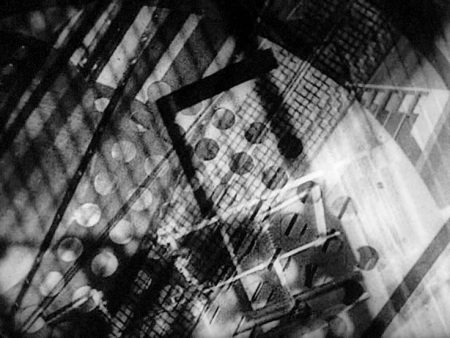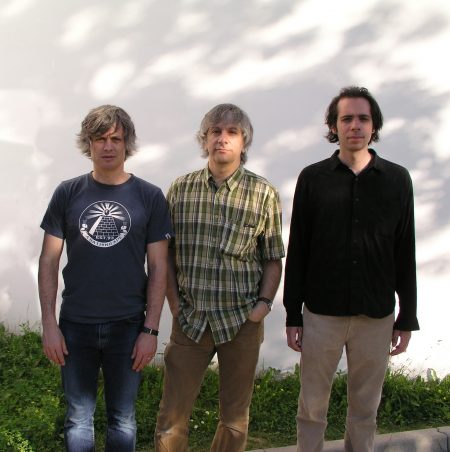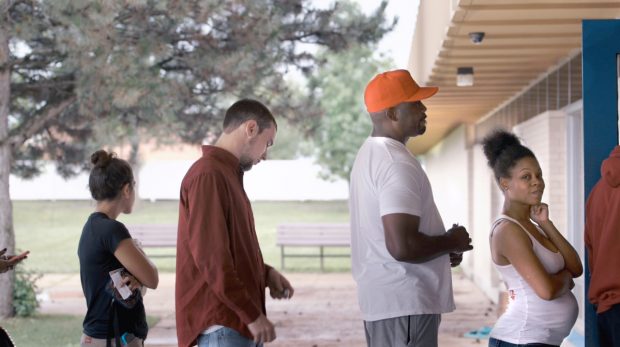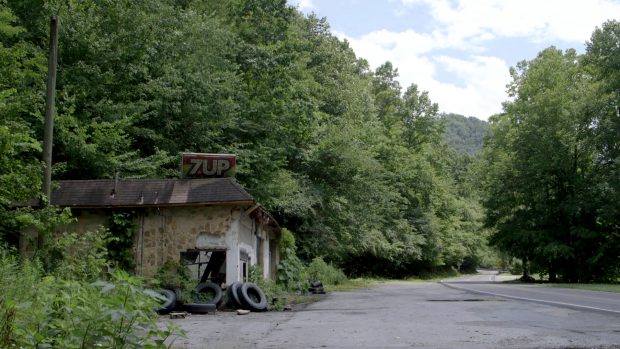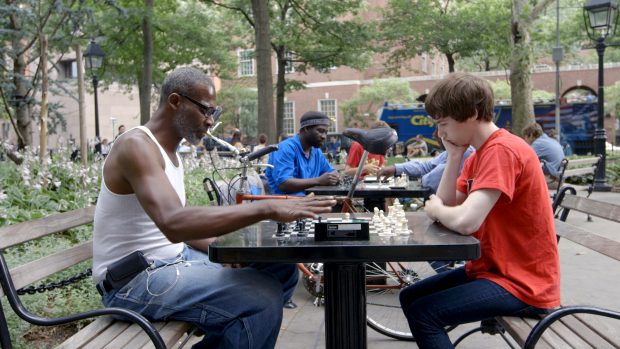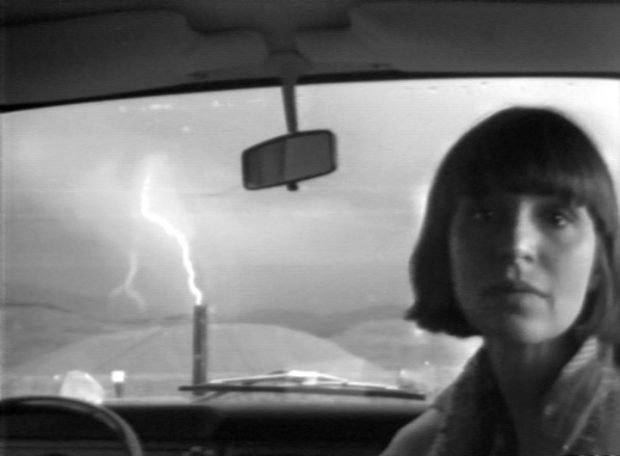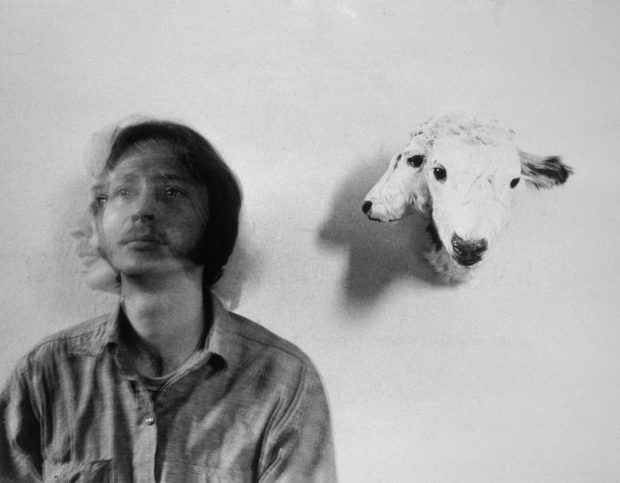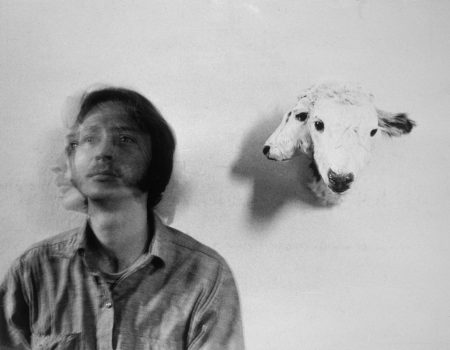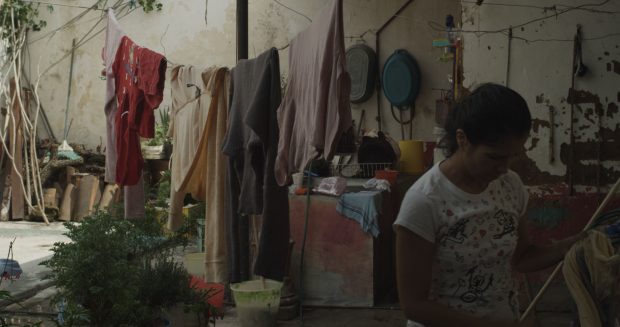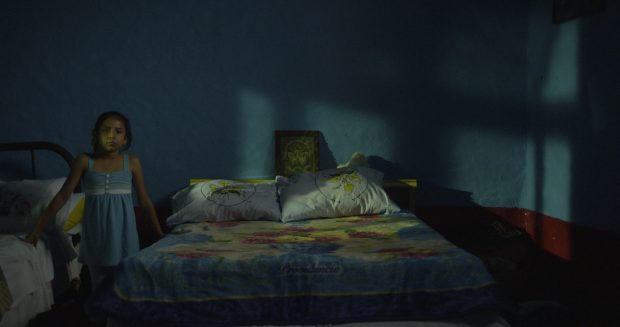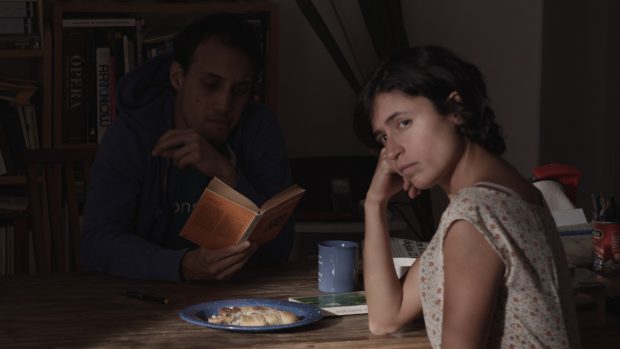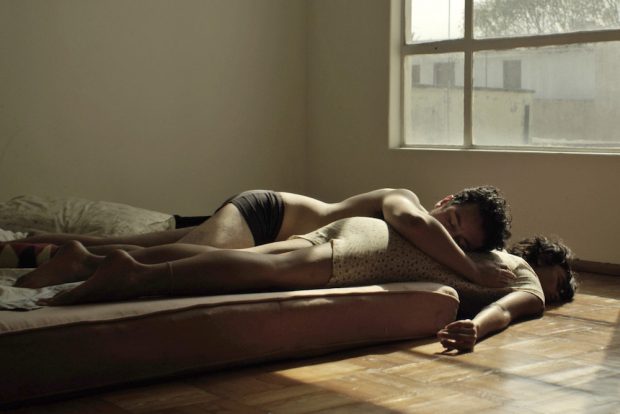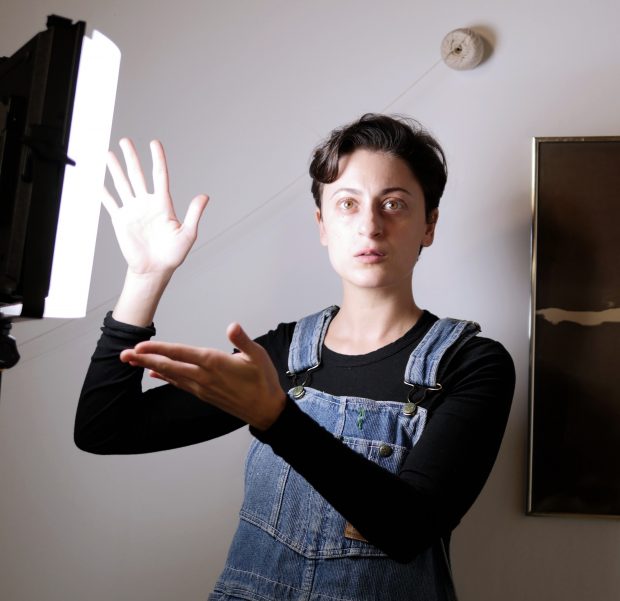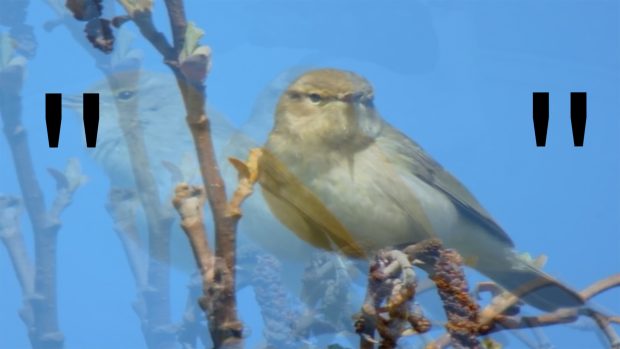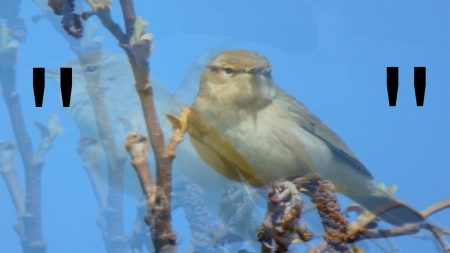Thursday, December 1 – Text of Light and films by László Moholy-Nagy
Posted by | Amy Beste | Posted on | November 18, 2016
The Art Institute of Chicago, Rubloff Auditorium (please use Modern Wing entrance, 159 E. Monroe Street)
FREE, registration required. Register here.
Film and photography played central roles in the work of pioneering artist and designer László Moholy-Nagy, who experimented with light, abstraction, and staccato montage throughout his career. For this program, the improvisational group Text of Light, led by guitarists Lee Ranaldo and Alan Licht, performs alongside a selection of Moholy-Nagy’s radically inventive works including the spectacular Lightplay: Black-White-Gray (1930) and Berlin Still Life (1932), a portrait of the city’s economic climate in the years leading up to World War II. Joined by percussionist Tim Barnes, the musicians layer guitar, effects, and low-grade feedback, playing off one another to generate new aural spaces and insight to Moholy-Nagy’s visionary work.
1929–2016, Germany/France/USA, multiple formats, ca 50 min
Presented in collaboration with the Art Institute of Chicago in conjunction with Moholy-Nagy: Future Present.
Text of Light (2000) is a collective of experimental musicians who perform live, improvised scores to works by American avant-garde filmmakers, primarily of the 1950s and ‘60s. The group has performed at the Victoriaville Music Festival, Canada; Three Rivers Film Festival, Pittsburgh; Walker Art Center, Minneapolis; Centre Georges Pompidou, Paris; and the Whitney Museum, New York; and toured Europe in addition to playing various clubs and cinemas in New York and elsewhere. Founded by Lee Ranaldo and Alan Licht, members of the group have included Christian Marclay, DJ Olive, William Hooker, Ulrich Krieger, and Tim Barnes.
László Moholy-Nagy (b. 1895, Borsód, Austria-Hungary; d. 1946, Chicago) was an abstract painter, designer, typographer, photographer, filmmaker, and theorist who believed in the integration of technology and industry into the arts. He was an influential professor at the Weimar and Dessau Bauhaus and established the highly influential Institute of Design in Chicago. His posthumous exhibitions include In Memoriam: László Moholy-Nagy, the Museum of Non-Objective Painting, New York (1947); László Moholy-Nagy, Museum of Contemporary Art, Chicago, and Solomon R. Guggenheim Museum, New York (1969); László Moholy-Nagy, Instituto Valenciano de Arte Moderno Centre Julio Gonzalez, Valencia, Spain (1991); Technical Detours: The Early Works of Moholy-Nagy Reconsidered, Art Gallery of the CUNY Graduate Center, New York (2006); Laszlo Moholy-Nagy: Retrospektive, Schirn Kunsthalle, Frankfurt (2010); Moholy-Nagy: El arte de la Luz, Circulo de bellas artes, Madrid (2010); and Moholy-Nagy: Future Present, Solomon R. Guggenheim Museum, New York, Art Institute of Chicago, and the Los Angeles County Museum of Art (2016–17).
Tags: 2016 > Abstract > Alan Licht > Art Institute of Chicago > audiovisual performance > Experimental Music > László Moholy-Nagy > Lee Ranaldo > Non-Fiction > Tim Barnes
On Brett Story
Posted by | Paris Jomadiao | Posted on | November 15, 2016
We are thrilled to present writer & filmmaker Brett Story’s film, The Prison in Twelve Landscapes, an absorbing meditation on the unexpected ways prison shapes lives and landscapes far beyond its walls. To accompany the film, Story recommends the following five books on carceral geography: an approach to analyzing incarceration and policing in spatial terms, drawing from the discipline of human geography. For Story’s detailed analysis of each book, please visit the original post on the Verso Books’ Blog.
Five Book Plan: Carceral Geography
- Golden Gulag: Prisons, Surplus, Crisis and Opposition in Globalizing California by Ruth Wilson Gilmore (University of California Press, 2007)
- Progressive Punishment: Job Loss, Jail Growth, and the Neoliberal Logic of Carceral Expansion by Judah Schept, (New York University Press, 2015)
- Solitary Confinement: Social Death and its Afterlives by Lisa Guenther (University of Minnesota Press, 2013)
- The London Hanged: Crime and Civil Society in the Eighteenth Century by Peter Linebaugh (Verso Books, 1991/2006)
- Incarcerating the Crisis: Freedom Struggles and the Rise of the Neoliberal State by Jordan T. Camp (University of California Press, 2016)
Tags: 2016 > Brett Story > carceral geography > Cinema > Documentary > film > reading list
Thursday, November 17 – Brett Story: The Prison in Twelve Landscapes
Posted by | Paris Jomadiao | Posted on | November 11, 2016
“An impressive, genre-subverting work” —Filmmaker magazine
The Prison in Twelve Landscapes, by the award-winning filmmaker and geographer Brett Story, is an absorbing meditation on the unexpected ways prison shapes lives and landscapes far beyond its walls. Shot across the United States, the film highlights ordinary places tied to the penal system by location, family, and economy: a California mountainside where female prisoners fight the region’s raging wildfires, a Bronx warehouse producing inmate care packages that adhere to New York’s arcane regulations, and an Appalachian coal town betting its future on the promise of prison jobs. Together these vignettes raise important questions about race, power, poverty, and the complex systems that sustain mass incarceration.
2016, Canada / USA, DCP, 87 min + discussion
Brett Story (b. London, England) is a writer and nonfiction filmmaker based out of Toronto and New York. Her first feature-length film, the award-winning Land of Destiny (2010), screened internationally and was broadcast on both Canadian and American television. Her journalism and film criticism have appeared in such outlets as CBC Radio, the Nation magazine, and N+1. She was the recipient of the Documentary Organization of Canada Institute’s New Visions Award in 2014 and the Governor General’s Gold Medal for Academic Excellence in 2016. Story holds a PhD in geography from the University of Toronto and is currently a postdoctoral research fellow at the Center for Place, Culture, and Politics at the City University of New York Graduate Center.
On Jacolby Satterwhite
Posted by | Paris Jomadiao | Posted on | November 10, 2016
We are excited to welcome graduate student Caroline McCraw to write for us this week. In her essay, McCraw discusses Satterwhite’s body of work, which combines dance, 3D animation, and the family archive.
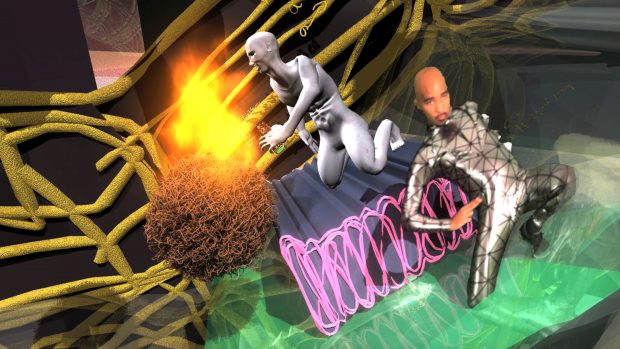
Still from Reifying Desire 5 (Jacolby Satterwhite, 2012). Image courtesy of Electronic Arts Intermix.
Jacolby Satterwhite is a New York-based artist from Columbia, SC, whose multidisciplinary work explores identity and personal history through video, performance, animation, drawing, and printmaking. After studying painting at the Maryland Institute College of Arts (BFA 2008) and the University of Pennsylvania (MFA 2010), Satterwhite began to focus on performance and animation as a way to examine personal and public mythologies through the signification of his own body. Satterwhite has gained attention for his original approach to integrating CGI technology, family archive, pop culture, dance performance, and fantasy.
Many of Satterwhite’s pieces incorporate drawings and text from his mother, Patricia Satterwhite, who sketched hundreds of domestic inventions while dealing with mental illness. Jacolby Satterwhite uses these drawings as inspiration for dance movements and also transcribes them into 3D forms through a meticulous digital tracing process. In The Matriarch’s Rhapsody (2012), Satterwhite situates family photographs alongside copies of his mother’s drawings and his own animated reproductions of the drawings. This rearrangement and digitalization of a family archive is taken even further in Reifying Desire (2011-2014), a series of six videos wherein his mother’s inventions appear alongside Satterwhite’s own body in phantasmagoric animated environments.
Satterwhite cites many influences, including video games, Janet Jackson, voguing, Fluxus, William Forsythe’s choreography, queer phenomenology, Renaissance painting, and of course, his mother. While Satterwhite turned to animation as a way to access his own voice beyond the constraints of the Western painting canon, the videos maintain a painterly attention to composition and tactility, with swinging shots that explore the dense and ever-mutating imagery. The animations move and rearrange, push and pull, morph, fill, and empty to the beat of dance music. His mother’s sketches hover and shift throughout the shots like pop-up advertisements that grow to become part of the landscape.
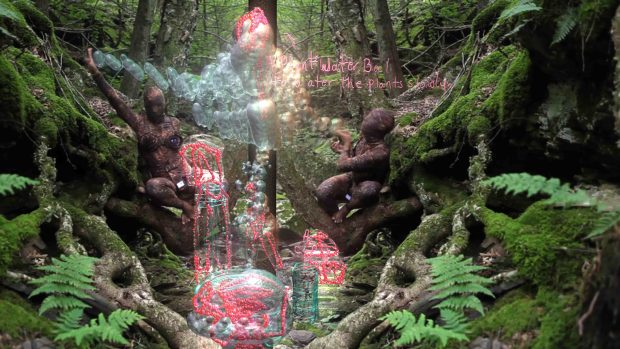
Still from Reifying Desire 2 (Jacolby Satterwhite, 2012). Image courtesy of Electronic Arts Intermix.
In Reifying Desire 5 (2012), the animated bodies of five women sensually pose in a replication of Picasso’s Les Demoiselles d’Avignon (1907). Satterwhite’s own body, filmed in front of a green screen, flies above them. Flashes of the original painting appear, and a digital transcription of one of his mother’s sketches dangles above the women like a neon sign: “For Pussy Power, pour bubble bath into the bathtub into the water and soak for a while to turn the smell of pussy off.” The text functions as both an inspiration and caption for his work; the simultaneous presence of the domestic, erotic, and cosmic allows for Satterwhite to question the limits of a space and the limits of a body.
In Reifying Desire 3 (2012), an androgynous figure’s stomach is probed by several other figures before ultimately giving birth to a glowing, scribbled cross. Satterwhite is likewise gestating and producing a new lexicon of movements and images necessary for discussing those experiences that defy the borders of identity, politics, and language. While Reifying Desire is about the manifestation of desires, whether erotic or entrepreneurial or societal, it is also about desire for the reification of that which is marginalized.
On Paul Kos
Posted by | Paris Jomadiao | Posted on | November 3, 2016
This week, we welcome back George Price of Video Data Bank to write for us. In his essay, Price discusses the work of video and conceptual artist, Paul Kos, a key figure in the West Coast whose career spans nearly 50 years.
I am delighted to welcome conceptual artist and educator Paul Kos to Conversations at the Edge this week as part of Video Data Bank’s (VDB) 40th Anniversary Celebrations!
This Fall 2016 VDB at the School of the Art Institute of Chicago (SAIC) celebrates forty years of fostering awareness and scholarship of video and media art. From VDB’s humble beginnings in a small closest at the back of SAIC’s library, to becoming one of the world’s leading resources for video by and about contemporary artists, VDB has pioneered far-reaching support for moving image artists, advocating for this most democratic and widely distributed of art forms.
Over its forty-year history VDB has grown to include the work of more than 600 artists and 6,000 video art titles. These titles describe the development of video as an art form from the late 1960s to the present day. During that time VDB has proudly supported countless emerging and established artists, including Paul Kos who we have had the delight of collaborating with since the mid-1980s.
Kos has been a practicing artist for five decades, working between video, performance, and sculpture. Throughout his practice he has responded to simple, humble materials, and the indigenous elements of specific sites, which are mined for their physical properties and metaphoric possibilities. In videos such as Lightning (1976), Kos creates self-reflexive psychological spaces through the observation of natural phenomena. This early tape, originally part of the legendary Castelli-Sonnabend video art collection, poses questions regarding observation and the nature of reality. During the 80-second video, Kos’s then-wife, Marlene sits inside a car, facing away from a lightning storm. As the lighting strikes the barren landscape she turns to observe the electrical bolts. She repeatedly misses the event by a few seconds every time—highlighting the privileged position the camera holds.
These conceptual experiments, rooted in materiality, run through Kos’s body of work. Many incorporate the body—from an action consisting of fashioning a magnifying lens from a block of ice to a sculpture of an inclined plane that invites its audience to attempt to climb it—as a physical register for the success or failure of the body and humanity itself. It is because his conceptual work takes a real, physical, and sculptural form—rather than the more cerebral philosophical framework favored by his East Coast contemporaries—that his bone-dry wit and sincere interest in the metaphorical makes Kos, according to Charles Desmarais of the San Francisco Chronicle, “one of the Bay Area’s most entertaining, influential, and important living artists.”
Thursday’s screening will include highlights from Paul’s upcoming DVD box set Paul Kos: Sympathetic Vibration, published as part of VDB’s 40th Anniversary Celebrations. This box set will feature 25 poetic works, along with a 50-page monograph containing specially commissioned essays that expand upon Paul’s practice by art scholar Constance Lewallen and SFMOMA’s Curator of Media Arts, Rudolf Frieling. I hope that you will join us for an evening filled with humor, wit, and the unexpected.
Thursday, November 3 – Paul Kos: Sympathetic Vibrations
Posted by | Amy Beste | Posted on | November 2, 2016
A pioneering figure in West Coast video and conceptual art, Paul Kos makes poetic and often playful works from humble materials mined for their physical properties and metaphorical possibilities. In the elegant Ice Makes Fire (1974–2004), Kos fashions a block of ice into a lens that can start a fire; in the enigmatic Warlock(ing) (1971), he sets small game traps to catch the rain. In this rare evening with the artist, Kos presents a collection of videos made across 40 years and discusses the principles of his practice.
1970–2007, USA, video file, ca 60 min + discussion
Presented in collaboration with Video Data Bank (VDB) as part of the organization’s 40th Anniversary Year, this program also launches the VDB-produced box set Sympathetic Vibrations: The Videoworks of Paul Kos.
Paul Kos (b. Rock Springs, WY) works in sculpture, installation, video, painting, drawing, photo, and performance. Kos was a leading figure of the early Bay-Area conceptual art movement and was also among the first wave of artists to weave sound, video, and interactivity into sculptural installations. Kos is the recipient of numerous awards including the National Endowment for the Arts fellowship in the visual arts (1974, 1976, 1982, 1993); National Endowment for the Arts Media Arts Grant (1986); Louis Comfort Tiffany Foundation Fellowship (1985); and Flintridge Foundation Fellowship award (1999). His work has been installed in multiple solo presentations including those at the San Francisco Museum of Modern Art (1987); Walker Art Center, Minneapolis (1987); Berkeley Art Museum, University of California (2003); and the Museum of Contemporary Art San Diego (MCASD) (2003). Kos’s work has also been exhibited in group shows at a range of international institutions: Palais des beaux-arts, Charleroi, Belgium (1983); MCASD (1996); MoMA, New York (1984, 1985, 1997); Museum of Contemporary Art, Taipei (2001); and Getty Research Institute and J. Paul Getty Museum, Los Angeles (2008). He lives and works in San Francisco, CA.
On Nicolás Pereda
Posted by | Paris Jomadiao | Posted on | October 27, 2016
We are excited to welcome graduate student Mev Luna to write for us this week. In their essay, Luna reflects on the work of Mexican filmmaker Nicolás Pereda whose films intertwine documentary and narrative to portray everyday life in Mexico.
Nicolas Pereda is a Mexican filmmaker whose films are known for their enigmatic sensibility, minimal dialogue, and beautiful, often drawn out shots. He has directed nine features and three short films including Greatest Hits (2012), Los ausentes (2014) and Summer of Goliath (2010) which will be screened at The Block Museum on October 28th. Filmed in a style evocative of documentary and blurred with fiction, his films poetically unpack issues of class and gender. Minotaur and The Palace pair well together, as they depict subjects from very different socio-economic backgrounds in Mexico.
In El Palacio, or The Palace, a group of intergenerational women live together, waking and sleeping in tandem. This rhythm is established in the opening shot, as the group brushes their teeth over a communal sink; a mundane action rendered as a chorus of repetitive gestures and scrubbing sounds. The camera allows us to stay with them until, one by one, each person has spat, rinsed and left.
As they go about their respective daily chores, we are introduced to another character – a female voice coming from off camera. The voice questions, scolds and sternly informs them of the proper way to engage their task. But she also speaks with concern, taking a protective tone, one that only someone who has also been in the same position could embody. In this way, the film brilliantly captures the more nuanced aspects of power-relations.
Through a series of role-playing interviews toward the end of the film, the voice employs a number of manipulative interrogation tactics. During these interviews, the women are instructed on the subtlety of coded language, directed to alter their answers and mask their own status in false claims, such as reducing the number of children they have. Deflecting the power structure of hired labor, the voice continually refers to a “they” when displeased by the women’s answers. As if “they,” the hypothetical employers, are dictating her demeanor and instructions. Through this process, the women in The Palace are not only being instructed on how to perform domestic tasks, but learning the role of subservient.
By contrast, set in an apartment in Mexico City, Minotaur is a film depicting three young adults and their leisurely lifestyle. The films’ namesake, Minotaur, was a figure in Greek mythology and the cannibalistic offspring of an extramarital affair between Minos’ wife Pasiphaë and the Cretan Bull. To contain Minotaur, Minos commissioned a large labyrinth. As if taking its cue from the creature’s final habitat, the film languidly follows the friends as they lounge, nap, and read in their Mexico City apartment. Books are an important presence in the film, an indulgence indicative of the young intellectual class the actors personify.
Minotaur features Gabino Rodríguez, Luisa Pardo, and Francisco Barreiro from Pereda’s 2009 film, Juntos. These three have a comfortable dynamic, even lying on top of each other as they rest. At one point, Rodríguez falls asleep with a book in his hand and Luisa carefully pries it out, picking up the reading where he left off.
Speaking about the film, Pereda shares that his interest was “in creating a surreal atmosphere, and not a melodrama about class relations.” Indeed, the film is an inverse of lucid dreaming, and there is a sleepiness to this waking state. The film is almost entirely contained to the apartment and soft, natural light spills in through the windows, diffused by curtains or encased by the outline of the window sill. With the exception of when Luisa, book in hand, leans out of the window, her figure almost lost in the direct sunlight and peripheral view of the camera. In the near distance we hear loud construction noises, reminding us that while these three cycle through siestas, the outside world is at work.
One can imagine that includes the seventeen women in The Palace. Each with their own mythos, Pereda’s films stand alone. When screened together, their shared formal investigations of disparate domestic spheres build a complicated and rich relationship to class and the unfolding of time.
Nicolás Pereda: Minotaur and The Palace – Thursday, October 27
Posted by | Paris Jomadiao | Posted on | October 21, 2016
Thursday, October 27 | Join us next week for a screening and discussion with Mexican filmmaker Nicolás Pereda!
Nicolás Pereda’s extraordinary films intertwine documentary and narrative to portray everyday life in Mexico. In his first Chicago appearance, Pereda presents two recent works, each a suggestive fable of labor and leisure. The Palace (2013) follows an enigmatic household of women and young girls who train each other to become housekeepers. The puzzle-like chamber piece Minotaur (2015) focuses on a trio of young adults as they read, sleep, and commune in the soft light of a Mexico City apartment. In Spanish with English subtitles.
2013–15, Mexico, DCP, ca 91 min + discussion
Presented in collaboration with the Mary and Leigh Block Museum of Art, which presents Pereda’s 2010 feature Summer of Goliath on Friday, October 28.
Nicolás Pereda (b. Mexico City) is a filmmaker whose work explores the everyday through fractured and elliptical narratives using fiction and documentary. He has been the subject of more than 20 major surveys worldwide, including at the Harvard Film Archive, Cambridge; Jeonju International Film Festival, Seoul; and TIFF Cinematheque, Toronto, among others. His films have premiered at major international film festivals including Cannes, Berlin, Venice, Locarno, and Toronto, and his work has been exhibited in the Reina Sofía, Madrid; the National Museum of Modern Art, Paris; the Guggenheim Museum, New York; and MoMA, New York. In 2010 he received the Premio Orizzonti Award at the Venice Film Festival. He is the Director of the Filmmaking Program, a new BFA program at the Mason Gross School of the Arts at Rutgers University in New Jersey.
On Sara Magenheimer
Posted by | Paris Jomadiao | Posted on | October 19, 2016
We are delighted to welcome George William Price of Video Data Bank to write for us. In his essay, Price reflects on the work of this week’s Conversations at the Edge artist, Sara Magenheimer.
I am delighted to welcome interdisciplinary artist Sara Magenheimer to Conversations at the Edge this week as part of Video Data Bank’s (VDB) 40th Anniversary Celebrations!
This Fall 2016 VDB at the School of the Art Institute of Chicago (SAIC) celebrates forty years of fostering awareness and scholarship of video and media art. From VDB’s humble beginnings in a small closest at the back of SAIC’s library, to becoming one of the world’s leading resources for video by and about contemporary artists, VDB has pioneered far-reaching support for moving image artists, advocating for this most democratic and widely distributed of art forms.
Over its forty-year history VDB has grown to include the work of more than 600 artists and 6,000 video art titles. These titles describe the development of video as an art form from the late 1960s to the present day. During that time VDB has proudly supported countless emerging and established artists, including Sara Mageheimer who we have had the delight of collaborating with since 2015.
Sara’s work is dense, complex, and multifaceted—from sculpture to performance, text and sound—she navigates these intersections and challenges our limited realms of perception. Works such as Slow Zoom Long Pause (2015) and The Rhythm of Plain White (2014) present the viewer vast amounts of information in fragments and glimpses, mediating the tactual depth of sight, sound, and sense. Both videos play with language as if it were a physical form, layering digital voices, birdsong, and white noise like sediment settles over millennia. We the viewer are immersed in the moving image—an active participant—surrounded by shifting temporal planes and swirling disembodied voices.
This kind of immersive video practice is directly tied to Sara’s involvement in a performance-driven collaborations with both her peers and her audience. These collaborations include producing an immersive soundtrack for a recent exhibition of painter Amy Sillman’s work and inviting audience members to input words into a web-based “mad lib” political acceptance speech, which they could perform from a teleprompter to a live audience of friends, strangers, and museum visitors. Touching on Marshal McLuhan’s observations of a return to a pre-literate age through total sensory immersion, Sara and her collaborative projects endeavor to envelop the audience in a seamless web of tactile sound and unexpected visuals. Just as with her videos, Sara moves her audience to not only consume spectacle but to actively participate in it through the pushing and pulling of the boundaries of language, both in its oral and written forms.
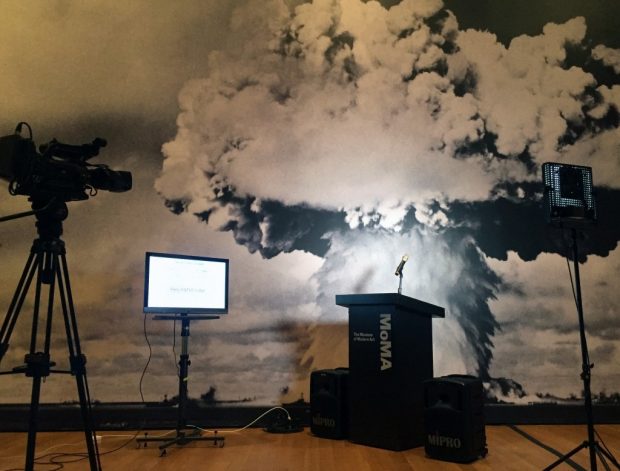
Sara Magenheimer, “I AM THE FIRST _____ PRESIDENT OF THE UNITED STATES”. Comissioned by Recess as part of MOMA Pop Rally. Image courtesy of the artist.
Best is Man’s Breath Quality (2016) most completely addresses this post-medium condition and the redefining of cinematic boundaries seen in Sara’s sophisticated body of work. As a menacing voice guides us through the video we are confronted by images and sounds that appear and disappear before us. From primates engaging with their reflected selves to glowing jellyfish drifting through deep and dark oceans, our visual perception of the human figure is decentered, leaving only the grain of analog and digital voices recognizable to our senses.
Attempting to navigate between the fluent and articulate we are reminded of Rosalind Krauss’ argument that the post-medium condition is a plain where aesthetics and capital permeate all aspects of culture, from the highest-brow to the lowest form of pop culture. Sara’s videos are proposed sites of transformation and resistance—drawing on forbearers such Andy Warhol’s Exploding Plastic Inevitable or Nam June Paik’s Global Groove—pointing towards a dismantling of the mythology of America. She embraces the bastardized and hybridized nature of her practice through a masterful weaving of digital detritus, everyday objects, and the physical properties of sound.
Tags: 2016 > Language > Sara Magenheimer > Sound > Text > video > Video Data Bank
Sara Magenheimer: Slow Zoom Long Pause – Thursday, October 20
Posted by | Amy Beste | Posted on | October 14, 2016
In her arresting videos, Sara Magenheimer mixes humor and playfulness with a sophisticated inquiry into language and meaning-making. Using visual puns, graphics, and text-to-voice computer programs, her work explores the slippery dimensions of communication. In Seven Signs That Mean Silence (2013), two disembodied computer voices describe in-between places where meaning hides. In Slow Zoom Long Pause (2015), characters meditate on the many ways language fails.
2011–16, USA, multiple formats, ca 60 min + discussion
Presented in collaboration with Video Data Bank (VDB) as part of the organization’s 40th Anniversary Year.
Sara Magenheimer (b. Philadelphia) has widely exhibited, performed and screened her work. Recent exhibitions include White Columns, New York; Foxy Productions, New York; and Document, Chicago; among others. From 2004–10 Magenheimer performed in bands, touring extensively and releasing five records. She was the recipient of a 2014 Rema Hort Mann Foundation Grant, a 2015 Artadia Grant, and the Prix De Varti at the 2015 Ann Arbor Film Festival. Upcoming exhibitions include Art In General’s New Commissions in Riga, Latvia and a solo exhibition at The Kitchen in New York.
« go back — keep looking »